

|
|
|
Flags used in the Marshall Islandscompiled by Dirk H.R. Spennemann |
![]()
Over the duration of the European influecne in the Marshall Islands a number of flags were used and flown. This document compiles and describes these flags.Excluded are flags of ships known to have merely passed through the islands.
|
| pre-Colonial Period |

| Spanish State and War Flag (1843-1931). Until 1885 the Marshall Islands were de jure but not de facto Spanish territory. Unlike Pohnpei, and Yap , however, the Spanish never established a formal presence in the Marshall Islands. Thus this flag was never flown, although it nominally applied in the Marshalls. |
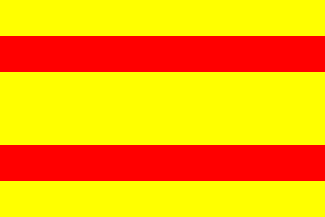
| Spanish Civil Ensign, 1785-1927. Until 1885 the Marshall Islands were de jure but not de facto Spanish territory. The Spanish Civil Ensign was flown by Spanish trading vessels, which were very and only rarely came to the Marshalls. |
| | Flag of the Ralik Islands, 1878-1885 Flag of the Ralik Islands which had five stripes of black-white-red-white-black, had been adopted by the Ralik chiefs following the Treaty of Friendship with Imperial Germany and the establishment of a German consulate in 1875. The flag was used from 19 November 1878 to 15 October 1885. The colours reflect the Imperial German colours. Even though the Imperial German flag was flown officially both on German and Marshallese ships from 19 September 1893, some residents continued its use. Flying the flag was formally made illegal on 7 March 1894 by virtue of the the Imperial regulation Verbot des Landeshauptmannes, betreffend Führung der sogenannten Marshall-Flagge (Prohibition by the Landeshauptmann regarding the flying of the so-called Marshalls flag) |
| | Company flag flown by ships owned by Johann Caesar Godeffroy & Sons. |
| | Company flag flown by ships owned by Franz Hernsheim & Co. Hernshiem established a trading emprire in New Guinea, the Marshall Islands and the Central and Eastern Carolines. |
| | Company flag flown by ships owned by the Deutsche Handels- und Plantagengesellschaft zu Hamburg. The DHPG emerged following the bankruptcy of the Godeffroy trading empire. It took over most of the trading stations of Godeffory's in the Marshalls. |
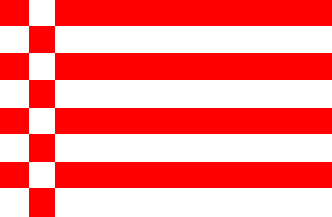
| Hansatic City of Bremen. Officially (re)-adopted (as merchant flag) 13 Nov 1891. In use since, except 1935-1947. Variants with even number of stripes permitted by the regulation of 1891. |
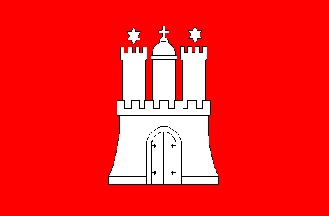
| Hansatic City of Hamburg. First officially adopted 14 May 1751, readopted 6 June 1834, 6 Oct 1897 and 6 June 1952. This flag was flown by ships registered in Hamburg before the German Empire civil Ensign became compulsory. The vessels owned by Godeffory, Hernsheim & Robertson and the Deutsche Handels- und Plantagengesellschaft would have flown this flag. |
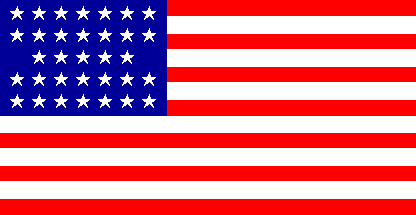
| United States of America The 33 Star Flag (1859-1861) flown by the Boston Missionary vessel when establishing the first Protestant Mission on Ebon |
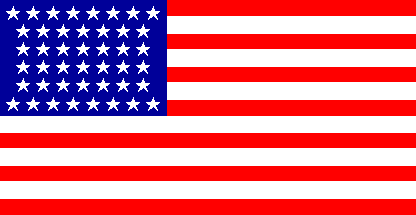
| United States of America 44 Star Flag (1891-1896) flown by the Boston Missionaries on Independence Day (4th of July) in the 1890s as well as from the missionary vessel Morning Star. |
|
| German Colonial Period |

| National Flag of the German Reich The flag served both as the national flag and the civil ensign. (National- und Handelsflagge). With the promulagtion of Allerhöchste Verordnung, betreffend die Ertheilung des Rechts zu Führung der Reichsflagge an Eingeborene des Schutzgebietes der Marshall-Inseln (Supreme ordinance regarding the granting of a permit to indigenous peoples of the Marshall Islands to fly the Imperial flag) on 19 September 1893 this flag became the sole flag to be flown by vessels owned by Germans and Marshallese residents in the Marshall Islands. It was reinforced by the Verordnung des Landeshauptmannes, betreffend die Führung der Reichsflagge durch Eingeborene der Marshall-Inseln (Ordinance regarding the flying of the Imperial flag by the indigenous people of the Marshall Islands) of 1 March 1895. |
| | Flag of the German Colonial Administration The Flag (Reichsdienstflagge im Bereiche des Auswärtigen Amtes, ie Foreign Office State Flag) was in use from 1892-1919. The National Service Flag in the Competence of the Foreign Office (Reichsdienstflagge im Bereiche des Auswärtigen Amtes) is the black-white-red flag with a white circular cut-out in the black and red stripe. In the white central disk an Imperial Eagle with the Imperial Crown. Adopted 8th November 1892 and 20th January 1893. Unlike the German colonies in Africa, as well as German New Guinea and Samoa, the Marshall Islands never had a special flag. Instead, they used the standard flag for the German colonies. |
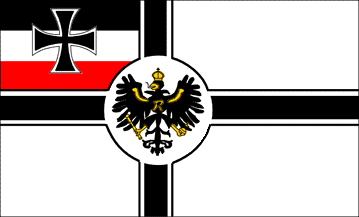
| Flag flown by German naval vessels operating in Marshall Islands 1867-1892 This flag was hoisted by the commander of the German warship S.M.S Nautilus, Kapitänleutnant Roetger, on Jaluit, Ebon, Mili, Majuro, Arno, Maloelap, Aur and Likiep, during the annexation of the Marshall Islands in 1885 |

| Flag flown by German naval vessels operating in Marshall Islands 1892-1903 |
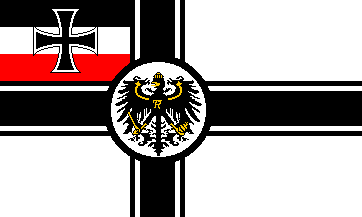
| Flag flown by German naval vessels operating in Marshall Islands 1903-1919 |
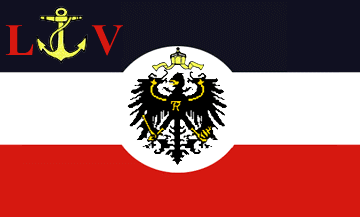
| Foreign Office Pilot Flag Lotsenflagge im Bereiche des Auswärtigen Amtes |
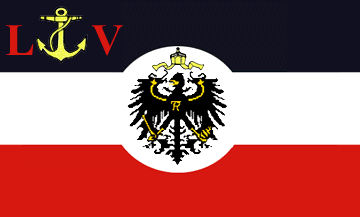
| Foreign Office Customs Flag Zollverwaltungsflagge im Bereiche des Auswärtigen Amtes. Used in the Marshall Islands from 1907. |

| Flag flown by merchant ships registered in the (German) Marshall Islands, 1893-1914 Based on the Verordnung des Landeshauptmannes, betreffend die Führung der Reichsflagge durch Eingeborene der Marshall-Inseln (Ordinance regarding the flying of the Imperial flag by the indigenous people of the Marshall Islands) of 1 March 1895 this was the sole flag for al vessels registered in the Marshall Islands. |
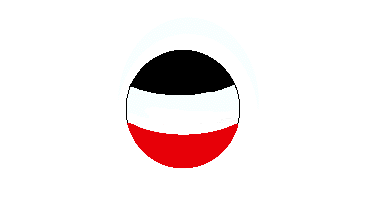
| Company flag flown by ships of the Jaluit Gesellschaft The Jaluit gesellschaft had been formed by the merger of the German trading interests in the Marshall Islands, namely those of Hernsheim & Co. and of the DHPG. The Jaluit Gesellschaft had been given the administration of the Marshall Islands protectorate as a concession company (from 1887-1906). The flag was the company flag and flown on company ships and over the main trading station on Jaluit. |
| | Company flag flown by ships of Burns Philp & Co. |
| | Company flag flown by ships of the Pacific Phosphate Company The Pacific Phosphate Company was a joint venture between the German Jaluit Gesellschaft and the British |

| United States of America The 45 Star Flag (1896-1908). The American missionary Clinton F. Rife steadfastly refused to fly the German flag, claiming that he had, at least morally, right of place. Rife flew the 48-States 'Stars and Stripes' from his boats. |
|
| Japanese Mandate Period |
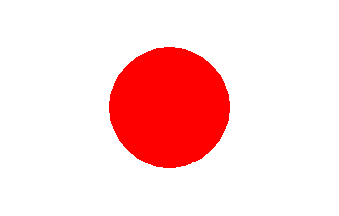
| Japanese Empire The Japanese national flag and Civil Ensign. |
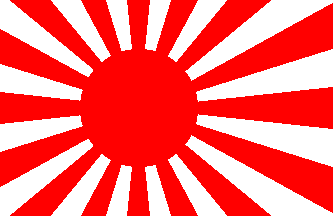
| Japanese Empire, Naval Ensign The naval flag was introduced in 1889 and that has 16 rays extending from the Sun "Mon" to the edge of the flag.. |
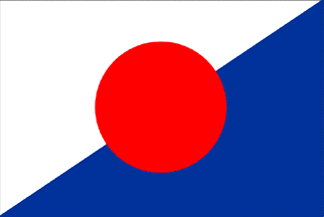
| Japanese Empire, Customs flag, circa 1905 The white stands for sky, blue for sea and the red disc symbolizes the sun rising from the horizon. |
|
| US Trust Territory Period |
| | United States of America The 'Stars and Stripes' is both the official flag of the USA and the ensign of the US merchant navy. |
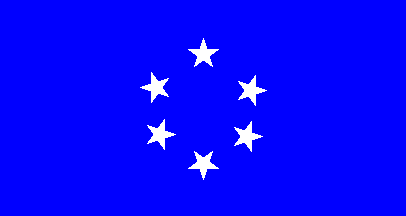
| Flag of the Trust Territory of the Pacific Islands The flag was proposed in 1947. It was adopted in 1961, the six stars representing the six districts of the Trust Territory of the Pacific Islands (Marshall Islands, Kosrae, Yap, Pohnpei, Chuuk, Palau and Saipan). |
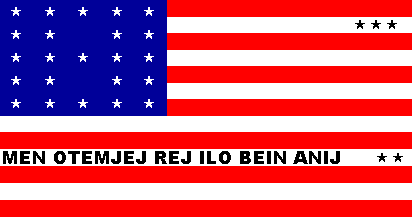
| Flag of the Bikini Atoll Bikini Atoll (and two near atolls) adopted in 1987 a flag to recall to the American government its responsibility in the nuclear pollution and its obligations to the islanders. The 23 white stars in the field of blue in the upper left hand corner of the flag represent the islands of Bikini Atoll. The three black stars in the upper right of the flag represent the three islands that were vaporized by the March 1, 1954, 15 megaton hydrogen bomb blast Bravo".
The two black stars in the lower right hand corner represent where the Bikinians live now, Kili Island, 425 miles to the south of Bikini Atoll, and Ejit Island of Majuro Atoll. These two stars are symbolically far away from Bikini's stars on the flag as the islands are in real life (both in distance and quality of life). |
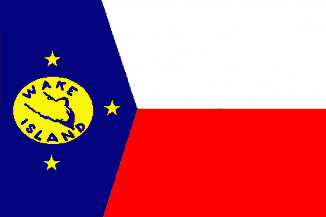
| Flag of Wake Island Inofficial flag of Wake Island. |
|
| Republic of the Marshall Islands |
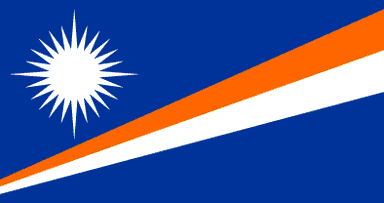
| Flag of the Republic of the Marshall Islands The deep blue background represents the Pacific Ocean. The white and orange bands represent the Ratak (Sunrise) and Ralik (Sunset) chains, respectively. The customary symbolism of orange as the color of bravery and white as the color of peace are also recognized. The star represents the cross of Christianity, with each of the 24 points signifying a municipal district of the RMI. The four main points represent the major centers of Majuro, Ebeye, Jaluit and Wotje. |
| | Dominion of Melchizedek Not recognised entity claiming authority over the northern Marshallese atolls of Bokak (Taongi). The 'Dominion of Melchizedek' exists only on the world-wide web. A seal has been published, but a flag could not be found for the compilation. |
| | Kingdom of Eneen-Kio Not recognised entity claiming authority over the northern Marshallese atoll of Wake (Eneen-Kio). The Kingdom of Eneen-Kioexists only on the world-wide web.The flag image has been copied from imagery provided on its website in 1997 (no longer on the website). |
|
| ||
The
Marshall
IslandsȘAn
Electronic Library
& Archive
of Primary
Sources is provided free of charge as an advertising-free
information service for the world
community. It is being maintained by Dirk
HR Spennemann, Associate Professor
in Cultural Heritage Management,
Institute of Land, Water and Society and School
of Environmental & Information Sciences, Charles
Sturt University, Albury,
Australia. The server space and
technical support are provided by Charles
Sturt University as part of its commitment
to regional engagement.
Dirk Spennemann 1999– 2004 |











